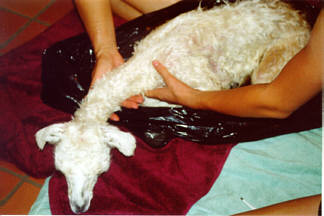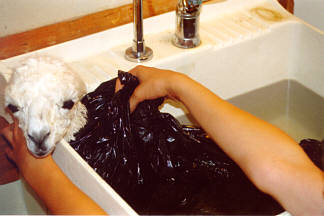Emergency Cria Warming
|
At birth, take a newborn cria's temperature to assure that it is normal.
A low body temperature will not allow the cria to absorb the nutrients from the colostrum.
|
If a cria is found in the winter, even though it may seem lifeless and frozen, many attempts at warming up the newborn have been successful and life and breathing is observed when the cria is warmed up. |
 |
|
 |
The fastest way to bring the body temperature up is to put the cria into a large plastic garbage bag - leaving the head out of course. Fill your sink with very warm water and submerge the cria into the warm bath. The protective plastic bag will keep the cria from getting wet or from a possible infection through the umbilicus. |
|
Allow the cria to remain in the hot water bath until the internal body temperature
is up to normal. This may take 30 minutes or more and the water may need to be re-warmed. |
Do It Yourself Cria Warmer ...............
(My favorite
method!) Get a cardboard box and cut the top flaps off. Now cut out a "door" in one end - like a doghouse opening. Cut a round hole 3-4 inches in diameter either in the top or the top end opposite the door-like opening.
Kush the cria and place the "cria warmer" over him with his head out the door-like
opening.
Put a hair dryer nozzle through the round hole and turn it on. Point the
dryer so that it isn't blowing directly on the cria. This will create a cozy
oven-like warmer and surround the cria with warm air. You can even place the cria on a
heating pad while in this box for added warmth - just don't turn it up too hot! Keep
your "cria warmer" on hand for that unexpected cold day that llama mama presents you
with a cria or especially for a premature born cria.
|

Front Side |

Back Side |

Return To Cria Care |
|

Return To Vet Info |

Return To Llama Management |

Return To Shagbark Ridge Llamas |
Disclaimer
All information on this website is provided as a public service, but we
cannot guarantee that this information is current or accurate. Readers
should consult with their veterinarian before acting on any treatments.
This document is copyrighted by Shagbark Ridge Llamas and no
part may be copied to another homepage. Permission is granted to link
to this page, copy this document in electronic form, or to print it for
personal use provided that this copyright notice is not altered or removed.
Updated Frequently
© 1996/2018 Shagbark Ridge Llamas

|